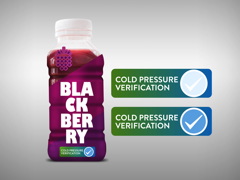CTI Reports High-Pressure Verification Technology
- Published: January 20, 2017
COLORADO SPRINGS, CO | Chromatic Technologies Inc. (CTI) announces the development of a patent-pending, high-pressure indicator “ink” applied to a food package that offers a visual inspection showing High Pressure Pasteurization (HPP) has been applied to the food product(s). Also known as High Pressure Processing, HPP treatment is used within the food and beverage industries. The HPP machines are designed to inactivate pathogenic bacteria and thereby extend shelf life. According to company, conventional “pasteurization” uses high temperatures, which degrade the taste and nutritional value of foods and beverages. 
Company adds that one of HPP’s great advantages is that the product subjected to HPP looks identical to products that have not undergone HPP treatment. This is also one of its weaknesses: It is impossible to know by visual inspection, whether or not a product has been HPP-treated. This creates a challenge for everyone in the supply-chain, which is why the company has developed a technology to address this challenge.
Approved by the US FDA and the US Department of Agriculture, HPP can be used for both organic as well as natural foods and pharmaceutical products and can be conducted at refrigerated temperatures. As such, HPP does not alter heat-sensitive foods such as meats, fruits, and vegetables. According to the company, while the benefits of HPP have a lengthy history, modern advances have shown that, in addition to the health benefits, the HPP process allows a product to be shipped/stored refrigerated rather than frozen, providing considerable economic and time savings.
The immediate demand that CTI is fulfilling is from food service companies who are receiving shipments of HPP foods such as meat, seafood, cheese, juice, and vegetables and need to give their restaurants or grocery stores a quick visual indicator on whether they should accept delivery of food products. Patrick Edson, chief marketing officer of CTI, says, “If you’re the vice president of food safety at a large restaurant or grocery franchise with a national supply chain, you are managing a significant risk profile of millions of units of food packaging being delivered to your business under the assumption it has been processed through HPP. Customers tell us, ‘We only need one package to bypass the HPP machine and show up at a restaurant, and we have a huge problem. A quick visual inspection at our restaurants to see that the food has been subjected to high pressure mitigates substantial risk. It also provides regulatory agencies with the ability to confirm that the foods have undergone HPP.”
The patent-pending HPP indicator technology is delivered via an ink that can be printed on the exterior of most packages for the marketplace. The ink is clear when printed and then increases in color as it’s exposed to the very high isostatic pressures found in the HPP process. The first generation of technology can differentiate between pressure exposure <20,000 psi, 20,000 psi, 30,000 psi and >40,000 psi, says Edson.
HPP verification technology is generally printed in conjunction with conventional inks on a label or substrate prior to shipping to food converter. It is done with an additional print station and is currently available in water-based and UV-cured inks. Solvent-based inks will be available in the future if the demand justifies the development expense, says CTI.
CTI’s new ink technology for HPP also contains anti-counterfeiting features to ensure someone in the chain hasn’t simply printed an ink on the packaging claiming an HPP indicator.










